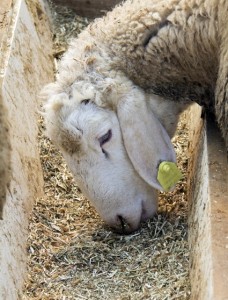Sheep Diseases
Ruminal Acidosis
The rumen becomes more acidic than it should because concentrate-based diets increase volatile fatty acids production in the rumen, increasing the fraction of propionate and lactate which lowers the rumen pH (Enemark, 2008). An acidic rumen leads to inflammation or rumenitis (Patra et al., 1993; Piercy and Kemp, 1990). This in turn causes diarrhoea, dehydration and sometimes death. The energy metabolism in the liver of the animal may also be altered due to a limited availability of carbohydrate substrate (Huber et al., 1984).
Clinical signs of mild sub-acute cases are diarrhoea, but with continued appetite. In more severe cases animals are depressed, they stop eating and are often found standing or lying with ears down and grinding their teeth, which is indicative of abdominal pain. Temperature is low, with rapid heart and respiratory rates and shallow breathing (Braun et al., 1992).
If animal health is threatened by a disease, as in the case of rumen acidosis, the risk of associated disorders increases for example, parakeratosis-rumenitis, liver abscesses, laminitis (Penner et al., 2011) and blood cell counts, especially leucocyte counts, and their response to stimuli (lipopolysaccharide (LPS), endotoxins) can be modified, thereby compromising the animal’s immune response (Penner et al., 2011).
Control and Prevention of Ruminal Acidosis
Tannins may be effective for slowing ruminal disappearance of barley to improve starch utilisation by ruminants (Martínez et al., 2005, 2006). The addition of live yeast may also be effective in reducing acidosis (Brossard et al., 2006). Sodium bicarbonate can also attenuate acidosis and lambs fed grain prefer foods and solutions containing sodium bicarbonate (Phy and Provenza, 1998a, 1998b).
Lower stocking densities and sufficient trough space should help to prevent bullying and ensure all sheep get a fair share of concentrate.
Treating Ruminal Acidosis
The affected animals require careful nursing if they are to recover. They should be brought indoors and fed good quality, mature hay and plenty of fresh water. Prop animals up with bales to prevent bloat. No concentrate of any kind should be fed.
In all but mild cases, vet advice should be sought immediately. Dehydration must be corrected by the administration of fluids. Oral administration of magnesium hydroxide or sodium bicarbonate is useful (Braun et al., 1992).
If the case is severe, the farm vet may administer corticosteroids, antibacterials and nutritional supplements (vitamins) by injection may also help to save the animal (Marchant, 1997).
Good Practice Based on Current Knowledge
- Keep sheep well away from feed storage areas
- Feed at least 60% of the dry matter as either fresh green food or unmilled forage
- Provide fresh, clean water at all times
- Provide sufficient trough space (>45cm/head in housed ewes being fed concentrate) (Phillips et al, 2014)
- Introduce changes in feeding gradually
- Mix home rations thoroughly
- Feed matured and whole grain
In a case of Ruminal Acidosis:
- Bring affected animals indoors and provide good quality, mature hay and fresh water
- Prop affected animals up with bales to prevent bloat
- Seek veterinary advice
- Correct dehydration
- Administer magnesium hydroxide or sodium bicarbonate orally (Marchant, 1997)


 American English
American English



Comments are closed.